11600 A LARGE BAROQUE PERIOD WALNUT TRESTLE ENDED AND FORGED IRON RECTANGULAR TABLE OF INTERESTING DESIGN AND PROPORTIONS Spain. Late Seventeenth or Early Eighteenth Century. Measurements: Height: 30 3/4″ (78 cm) Width: 87 3/4″ (228 cm) Depth: 27″ (68 cm).
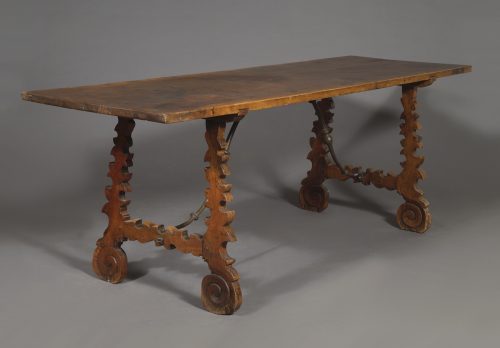
Research
Of walnut. The single plank solid rectangular top is supported by shaped and fretted trestle ends united by a conforming stretcher and terminating in bold voluted feet. The two ends united by a pair of decorative forged iron stretchers. Bearers (i.e. the two wooden parts that slot in to the top) may be old replacements. Old repairs commensurate with age and use.
The form of this Spanish baroque center table dates to the Renaissance, and was afterward known as a guard-room table. Frequently, as is the case here, Spanish “furniture was made to be dismounted—or rather folded”, permitting the pieces to be moved or carried more easily, a feature is also found in a variety of seating furniture. This type of table was made over an extended period of time, with the age of an example evinced primarily by its decoration.
“The trestle legs, four or six in number…supported a solid walnut top…”1 Walnut was most generally employed in furniture of this period, being of fine quality and a “noble representative of the national timber.”2 The legs are joined with wrought iron bars, sometimes crossed in an x-form, called fiadores (fasteners), and were themselves scrolled and ornamental. Unlike other European tables, the edges of Spanish tables were square rather than molded.
The the present table is a particularly large, slender example of the type, measuring over seven feet in length and two and a half feet in width. Furthermore, it is unusual in having fretted trestle ends of a more complex profile than is found in most other examples. In addition, the table legs terminate in scrolled feet, a feature also found on a seventeenth century table in the collection of the Museum of Industrial Arts, Madrid (today the Museum of Decorative Arts), illustrated in Spanish Interiors and Furniture, Volume 2 (Byne, 1922, Plate 134) (figure 1).3
Footnotes:
- Feduchi, Luis M. Spanish Furniture. New York: Tudor, 1969.
- Ibid.
- Byne, Arthur, and Mildred S. Byne. Spanish Interiors and Furniture, Volume 2. New York: W. Helburn, 1922. Plate 134.
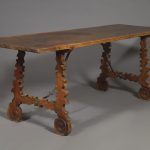
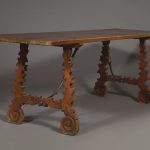
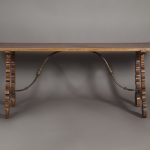
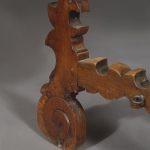
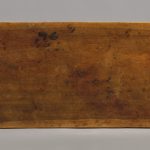
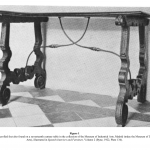
Comments are closed.